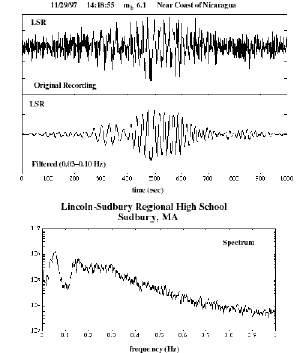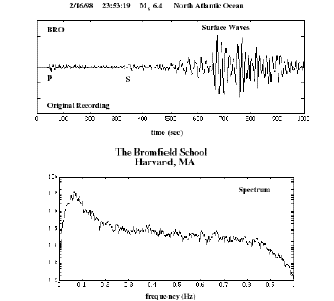March/April 1999
Guest Columnist:
Alan L. Kafka
Weston Observatory
Dept. of Geology and Geophysics
Boston College
Weston, MA 02493
DR. QUAKE GOES TO HIGH SCHOOL
Imagine this scene: You visit a high school classroom and have to beg the students to stop asking you thoughtful questions. An unlikely scenario, isn't it? After all, kids just don't find science engaging, right? And they only care about what will be on the test, don't they? Well, come along with me as I bring a seismograph to a local high school, and watch what can happen ....
Scene One: Delivering the Instrument
Students: "Hey, what's this thing? How does it work?"
Seismologist: "It records earthquakes by measuring the motion of the ground under your feet."
Students: "What if we jump up and down like this? Wouldn't that confuse you and make you think there was an earthquake?"
Seismologist: "Well, not really, because earthquakes have a particular 'signature' on the seismograms, so I could tell the difference between an earthquake and the ground vibrations caused by your jumping."
Teacher: "Yes, but what if they jumped up and down in the same pattern as the signature of an earthquake?"
Seismologist: "We compare the signals from one site to the next, so we would discover that your jumping was only recorded at this one station. Anyway, we could tell that it wasn't an earthquake because of the difference in frequency content."
Students: "The frequency what ...?"
Seismologist: "Ask me again later. Now, would you help me plug the sensor into the computer?"
One of the recent developments in the seismological community has been projects like the Princeton Earth Physics Project (PEPP) and MichSeis, in which seismographs are being installed in high school classrooms. These projects offer the rare opportunity for interaction between researchers in seismology and high school students and teachers. Real science in the classroom: so often advocated, so rarely enacted. Yet it can be done.
Scene Two: Where to Put the Sensor
Teacher: "How can this system record earthquakes sitting right there on the floor? Shouldn't we put the sensor somewhere else?"
Seismologist: "You know, I tried this out in my garage for a month before I came here. I put the sensor on the floor, and I recorded earthquakes. Look at these examples."
Students: "But what about all the other noise and vibrations here in the classroom?"
Seismologist: "Good question, but let's get this thing hooked up and running first, and then we'll talk about the best place to put the sensor."
In addition to installing seismographs in classrooms, curriculum materials have been developed that are associated with the high school seismographs. Examples of these curriculum materials can be viewed on the PEPP Web site
(http://lasker.princeton.edu/pepp.shtml). These curriculum materials could potentially be used by many students in many schools, giving them the opportunity to work with real scientific data (either recorded by their own station or downloaded from the Internet). Even without new curriculum materials, there are daily opportunities for teaching and learning about science on all levels just because of the mere presence of a seismograph. So far, though, only a small number of teachers and students have benefited from having seismographs in their own schools, monitoring earthquakes, and maintaining the stations.
Scene Three: Waiting for the First Earthquake
E-mail from teachers and students: "It's not working. What are we doing wrong? Why didn't we record yesterday's magnitude 6.1 earthquake in Nicaragua at our station? We aren't recording anything!"
Seismologist: "Let me show you how to transfer the data to me on the Internet, and I'll take a look at what you're getting."
The original recording, shown in Figure 1, is sent to me. I study the record, and it looks to me as though there's a surface wave hidden in the noise. I take the spectrum, and can see that there is a peak in the frequency band between about 0.03 Hz and about 0.10 Hz. Seems to me like what we are seeing is longer-period surface waves superposed on higher frequency noise, so I filter the record, getting the results shown in Figure 1.
|
|
Seismologist: "Looks like a fine recording of the surface wave. You really did record the earthquake. I'll stop by and show you."
I bring with me a program, written by Larry Cochrane of the Public Seismic Network in California, which can read PEPP files, calculate their spectra, and filter them. I show the teacher and students how to use the program, and filter the record of the Nicaragua earthquake.
I then explain to them that a seismogram is composed of a spectrum of signals of many different frequencies, and seismologists use spectral analysis and filtering to decipher what's on the record. This leads to a discussion about light and the colors of the spectrum, and also about the treble and bass dials on a stereo system. I explain to them that if we want to see seismic waves from a distant earthquake, we want to look at the "bass" part of the spectrum, and that a lot of the background noise is in the "treble" part of the spectrum.
Scene Four: Frequency Bands
Teacher: "How did you know what frequency band to look at?"
Seismologist: "I looked at a stronger earthquake recorded at another school, a magnitude 6.4 earthquake along the Mid-Atlantic Ridge [Figure 2]. I had a sense from looking at that seismogram and its spectrum that the peak between about 0.03 and 0.10 Hz was the signal from that earthquake, so I thought that would be a likely frequency band where we should look for the weaker signal in the seismogram. Also, this is the frequency band of 'classical' teleseismic recording of earthquakes. Plus, I knew that if we recorded surface waves, they would have a period of about 20 sec (0.05 Hz). All of this led me to search for the signal in the 0.03 to 0.10 Hz frequency band."
Students: "So this is all trial and error? We thought you were an expert! Don't you really know the answer?"
Seismologist: "Science is all about trial and error. We scientists think about questions at least as much as we think about answers."
|
|
Based on these types of experiences, the New England PEPP teachers and I decided to have a series of workshops at Weston Observatory to discuss how the high school stations could be used to enhance the students' experiences with science, and to brainstorm good research projects for the students. The teachers came to these workshops without being paid, simply because of their enthusiasm for the project and the enthusiasm they saw in their students. As a result of these workshops, we are now working on a project with the students and teachers to measure arrival times of P waves and look for anomalies beneath the stations.
Witnessing the enthusiasm and dedication of the teachers and students whom I have been fortunate to work with on the New England PEPP high school network, I feel the urge to get on a soapbox. Young people don't need more testing, more science education standards, and student assessment run amuck. What they do need is to experience the basic scientific activities of data gathering, hypothesis testing, and problem solving in a meaningful way. The opportunity to "play" with a real seismograph holds a fascination for all ages, and the seismological community is uniquely positioned to bring real science into the classroom.
Special thanks to the teachers responsible for operating the New England PEPP stations: Neil Gillis at McCall Middle School, Anita Honkonen at Lincoln-Sudbury Regional High School, Richard Maki at The Bromfield School, and Ed Ruszczyk at New Canaan High School.
SRL encourages guest columnists to contribute to "EduQuakes." Please contact Larry Ruff with your ideas. His e-mail address is eduquakes@seismosoc.org.
Posted: 7 April 1999


